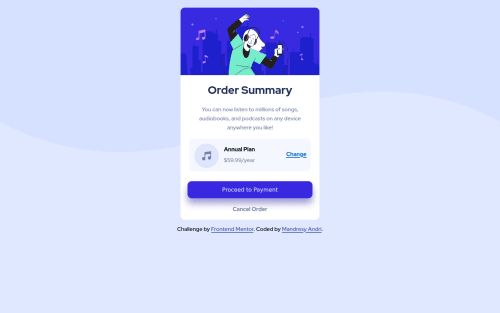Trying to solve order-summary-component

Solution retrospective
I know we are not saturday but I finished the challenge earlier that It seems. 🙂
You can see here my solution. Do not hesitate to leave a comment if you have some advice or code improvement. I'm open for all feedback. 🙃
Can you tell me what challenge can I do next ??
Thank you all !
Have a nice week ! 😉
Please log in to post a comment
Log in with GitHubCommunity feedback
- @javascriptooo
Hi there!
In your report, you are having 5 accessibility issues and 2 html issues.
To resolve them, add an
alttext attribute to eachimgtag (html);For accessibility, you always need to insert a landmark tag within the
body. I would insert a<main>landmark tag around the contents of the webpage. Here is some [documenation](https://www.w3schools.com/accessibility/ accessibility_landmarks.php.)Also, try adding to the
bodyselector in your css:height: 100vh;That should center the flex container from top to bottom.Nice Work! Hope that helps!
Steven
Marked as helpful - @itbeginswithi
Hi Andri, congrats on finishing your latest project.
To center your card, you can use absolute positioning. To try it out, add the following css lines to your container class:
position: absolute; top: 50%; left: 50%; transform: translate(-50%, -50%);If you try your website on smaller screens, you will notice that it overflows, for better responsiveness, you can:
1 - use the rem unit instead of px.
Each rem equals 16px by default, to avoid impossible rem to px calculations, you can set the font-size of your <html> element to 62.5% which is the result of 10[px] * 1[rem] / 16[px], this will make each rem equal to 10px.
2 - use media queries
Good luck!
Join our Discord community
Join thousands of Frontend Mentor community members taking the challenges, sharing resources, helping each other, and chatting about all things front-end!
Join our Discord